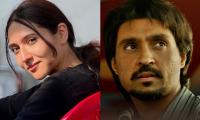Some 250-year-old Gizri village is one of the neighbourhoods under the Cantonment Board Clifton (CBC) in Karachi that has always been on the maps of the city.
But now the Defence Housing Authority (DHA) and the CBC have come up with creek clubs between the sea and the village, barring fishing activities of the people of the village. Graphic designer, photographer and visual artist Sohail Zuberi has based his work of art on the coastline of Karachi from the Capt Farhan Ali Shaheed Park to the Emaar Crescent Bay.
He wanted a place for his dogs to roam freely and found this spot of the beach over which the DHA has constructed a wall because, according to him, the authorities don’t want people to access the beach there.
“People can go and sit at the wall and look at the beach,” he said. He was addressing a session titled ‘Art in Your Mohalla: A Dialogue for a Megapolis of Harmony for the Future’ during the Karachi Literature Festival (KLF) on Sunday evening.
He shared how he used to walk at the wall and came across a few objects such as wood planks. He collected and brought them to his studio and realised that they had human interventions in them. “They had nails, they were painted, some of them were curved,” he pointed out.
From that point on he started venturing in other ancient sea villages in Korangi such as Ibrahim Hyderi, Rehri Goth, Chashma Goth and Lath Basti. He found pieces of Sheesham wood, which he said were generally not used any more. Some pieces of wood were fresh and some were worn out.
All of this, he said, culminated in a solo show after eight years in 2018 at the Koel Gallery. “I called the show ‘Archaeology of Tomorrow’,” he said. These woods wash up on the floor. Sometimes they’re taken back and sometimes they’re buried in the sand.
Zuberi pointed out that the communities from where he collected those woods are giving a lot to the government but they are highly marginalised and in small pockets. Replying to a question if the art has triggered any commitment towards the betterment of those communities, he said he has started talking about it in his lectures.
Diversified
Author and social worker Aquila Ismail, who also runs the Orangi Pilot Project (OPP), shared how much the city is diversified but everyone comes together at one point of the city, which is its beach: Sea View.
She said how after the separation of East Pakistan a huge influx of population from Bangladesh was observed in Orangi Town, which houses 2.3 million of Karachi’s population. “For any kind of programme to bring people together to understand the diversities, you have to study the phenomena that exist in places like Orangi,” she said.
At the OPP they began mapping the town in the field and not with the geographic information system. This mapping, she said, became a work of art, as it was done by looking at the community, the way they live.
“The mapping was not done by the OPP; it was done by the community itself,” she said. “When the community was involved in mapping, they were able to look at the old physical spaces. They were creating their own interventions in those spaces in terms of improving sanitation of the area or improving economic activities of the area.”
But first of all, she pointed out, the people had to understand the space. “The way they understood was by actually making the map, which is by placing a pencil on paper and then creating the lines, and those lines are the perfect form of art.” Architect Tariq Alexander Qaiser as well as curator and educator Romila Kareem also addressed the KLF session, which was moderated by art historian Niilofur Farrukh.
The image shows a tobacco company worker holding cigarettes. — AFP/FileHYDERABAD: An illegal cigarette factory...
This image shows the dead body. — AFP/FileAn incident unfolded in Quaidabad on Tuesday, resulting in one fatality...
Edhi Marine Services team is busy in a rescue operation in Karachi on March 17, 2024. — PPI An e-taxi driver...
Shah Abdul Latif University Khairpur building can be seen in this image. — Facebook/Shah Abdul Latif University,...
Representational image of a handcuffed man. — Pexels/FileHYDERABAD: A police operation was carried out in Hyderabad,...
A representational image showing a person handcuffed and standing behind bars. — AFP/FileThe SSGC has continued...







